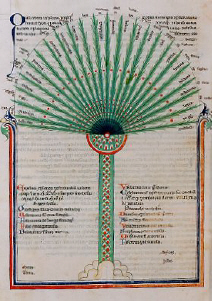For Plato, philosophy was a practice of and for death; a discipline of immortality aimed at the purification and separation of the soul—which was no longer regarded as the illusory phantom (eidolon) of the body, but as the immortal psuche—and which was now considered as the very essence of the being. By shifting the emphasis from the mortal body to the immortal soul, Plato initiated a philosophically oriented paideia, the final goal of which was a learning to live according to the highest metaphysical truth and virtue, to be attained by imitating God, the cause of all blessedness. Through an association with that which is divine—the good, beautiful and orderly (kosmios)—the philosopher attained to divinity and orderliness (kosmios). This was a way of life based on philosophy as presented by Pythagoras; but it would be wrong to suppose that Plato was in this way the only and inevitable route for all the earlier Hellenic and Oriental traditions that passed down to late antiquity.
Among the basic premises of Plato’s philosophy was the distinction between two orders of reality, Being and Becoming. The real noetic world, the realm of Being (or Being, Life, and Intelligence, according to the later commentators) contained the immaterial, eternal and unchanging Forms (eide). The realm of Becoming, by contrast, contained the shifting phenomena of the world, which were but imperfect imitations or copies of the Forms, i.e., the world of Becoming contained all sensible things about which no certain scientific knowledge was possible. The Platonic Forms were noetic paradigms, archetypes, and universals arranged in a hierarchy, crowned by the Form of the Good (or Beauty). They constituted the only true objects of divine knowledge. In the myth of Phaedrus they were contemplated by the charioteers of souls before they crashed into the world of Becoming, and were thereafter unable to contemplate the Ideas directly. In principle, the Platonic Forms or Ideas, were “Platonic” and somewhat “new” only in respect of their systematic rational formulation and philosophical expression. In their mythological and theological dresses (intimately related to corresponding hieratic rites), the so-called theory of Ideas and Archetypes can be traced back to the ancient Egyptian and Sumerian cosmogonies. Plato received this doctrine in its semi-Pythagorean form, along with conceptions of the ultimate metaphysical principles (the One, Limit, and Unlimited), Form and Matter—woven together through numerical harmony and the doctrine of the tripartite soul. But one ought to remember that Pythagoras, as a son of Apollo or even Apollo himself incarnated in human form (and thus tantamount to the Egyptian Horus), was “nameless” and his personal identity a mystery. It should also be noted that Plato wanted to be seen as an heir to Parmenides, a priest of Apollo the Healer, although he somewhat transformed or even rationally distorted both the Parmenidian paradosis and the primordial vision of the ancient sages.
According to Plato, the visible cosmos is “a shrine brought into being for the everlasting gods” (ton aidion theon gegonos agalma), a living and self-moved creature modeled according to the pattern of the Intelligible Living Being (i.e., the realm of Ideas, kosmos noetos) that is forever existent. The divine Demiurge models the world of Becoming on the world of Being, described as a complex system of Forms containing within itself all subordinate Forms whose likeness one can trace here below. Plato drew a close correspondence between macrocosm and microcosm, that is, between the structure of the entire noetic, psychic and material cosmos and the structure of the human being. The cosmological and metaphysical circles of Sameness and Difference were thus present both in the World Soul and the human soul. But, due to its broken wings the human soul had to leave the divine procession and descend to the realm of genesis. The task of the philosopher was thus to regrow his wings and to pass from the shadows of the sensible world to the divine realm, and to contemplate not the remote images, or shadows, but the Forms, or realities, themselves. This was the spiritual and intellectual way of recollection (anamnesis) which constituted the heart of Platonic philosophy.
